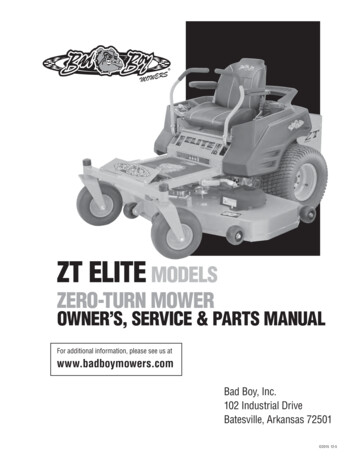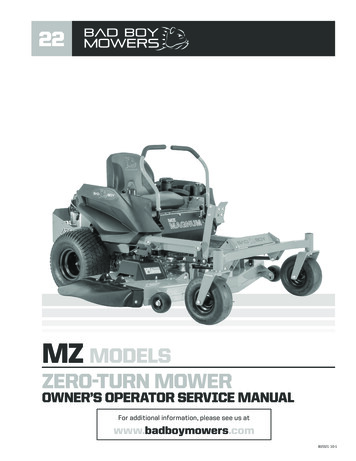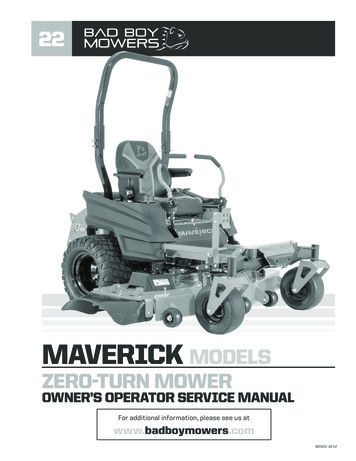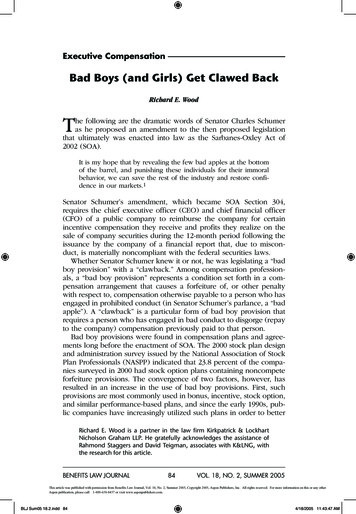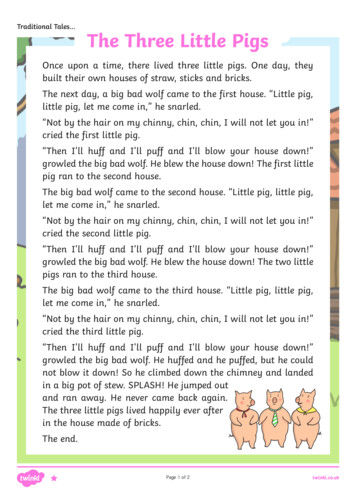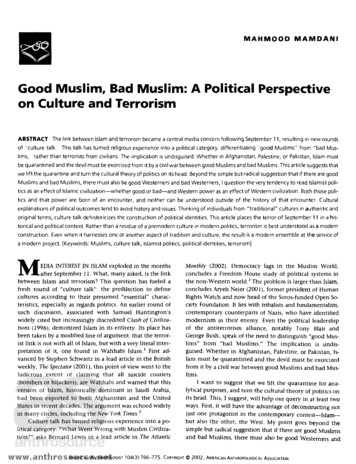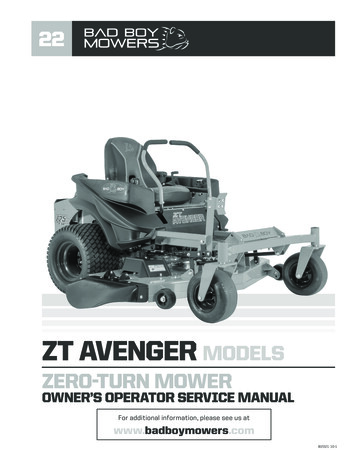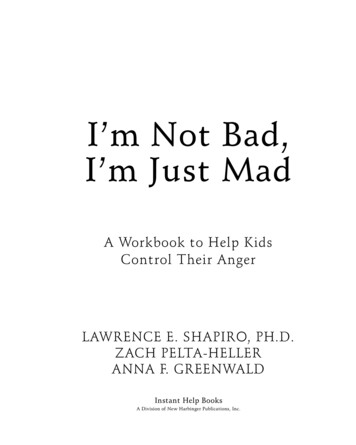
Transcription
I’m Not Bad,I’m Just MadA Workbook to Help KidsControl Their AngerLAWRENCE E. SHAPIRO, PH.D.ZACH PELTA-HELLERANNA F. GREENWALDInstant Help BooksA Division of New Harbinger Publications, Inc.
Publisher’s NoteThis publication is designed to provide accurate and authoritative information in regard to the subject matter covered. It issold with the understanding that the publisher is not engaged in rendering psychological, financial, legal, or other professionalservices. If expert assistance or counseling is needed, the services of a competent professional should be sought.Distributed in Canada by Raincoast BooksCopyright 2008 by Lawrence Shapiro, Ph.D., Zach Pelta-Heller, and Anna F. GreenwaldInstant Help BooksA Division of New Harbinger Publications, Inc.5674 Shattuck AvenueOakland, CA 94609www.newharbinger.comCover design by Amy ShoupIllustrations by Julie OlsonInterior photographs: Page 7 (bottom left) Jose Manuel Gelpi Diaz Dreamstime.Page 11 (middle) Vadim Ponomarenko DreamstimePage 12 (top and bottom) Monika Adamczyk DreamstimePage 103 (top) Roman Belykh DreamstimePage 103 (bottom) Dragan Trifunovic DreamstimeAll photos are models used for illustrative purposes only.All Rights ReservedPrinted in the United States of AmericaLibrary of Congress Cataloging-in-Publication Data on file with publisher1009109088First Printing7654321
ContentsvA Note to ParentsviiIntroduction for KidsSection I: Understanding Your AngerActivity 1There Are Different Kinds of Anger3Activity 2Your Face Shows Your Anger7Activity 3Your Body Tells When You Are Angry10Activity 4You Have Anger Buttons14Activity 5There Are Positive Ways to Express Anger17Activity 6Understanding All Your Feelings21Activity 7Reducing Stress in Your Life26Activity 8Being Smart About TV and Video Games29Activity 9Getting a Good Night’s Rest32Activity 10 Eating Better35Section II: Managing Your AngerActivity 11 Talking About Your Feelings41Activity 12 Using Deep Breathing to Calm Yourself44Activity 13 Relaxing Your Body47Activity 14 Managing Difficult Feelings49Activity 15 Taking a Positive Approach53Activity 16 Learning Positive Self-Talk56Activity 17 Developing Your Patience59Activity 18 Becoming a Good Problem Solver62Activity 19 Being Creative When You Are Stuck65Activity 20 Dealing with Being Annoyed68Activity 21 Thinking Before You Act71Activity 22 Handling Frustration75Activity 23 Keeping Track of Your Progress79
Section III: Dealing with PeopleActivity 24 Taking Responsibility for Your Feelings85Activity 25 Seeing Other People’s Points of View88Activity 26 Being a Good Listener91Activity 27 Getting Rid of Hurtful Words94Activity 28 Understanding Rules98Activity 29 Looking Friendly, Not Angry102Activity 30 Compromising106Activity 31 Being a Caring Person109Activity 32 Making Wrongs Right113Activity 33 Being a Good Sport116Activity 34 Holding Family Meetings120Activity 35 Cooperating with Others123Activity 36 Taming Your Need to Blame Others127Activity 37 Knowing What You Can and Can’t Change130Activity 38 Using Humor133Activity 39 Forgiving and Forgetting136Activity 40 Are You Ready to Control Your Anger?139iv
A Note to ParentsMany children today have problems with anger. In fact, researchers tell us that nearly50 percent of all children referred for counseling have difficulty controlling theiranger. Most often, this difficulty is not an isolated issue. Children with learningdisorders, attention deficit disorder, Asperger syndrome, and other problems often alsohave difficulty managing their anger and expressing it appropriately.The forty activities in this workbook can help children learn positive ways to managetheir anger, using the same techniques they would learn with professional counselors.These techniques are based on the theory of emotional intelligence, which assumesthat emotional, behavioral, and social skills can be learned in much the same wayas sports, music, or academic skills. Once learned, these skills will not only improveyour child’s behavior at home, they will also help your child with friends and with thedevelopment of habits that lead to school and work success.Each activity begins by highlighting the primary point. Next, there is a section thatintroduces a new emotional, behavioral, or social skill, followed by something forchildren to do, like a puzzle, a maze, a questionnaire to fill out, or a word search.Finally, there are follow-up questions for children to think about. They can answerthese questions out loud, but it will be most helpful if they write down their responses(or you can write down their dictated answers).While most of the activities can be done by children alone, they will be more effectivewhen you or another adult provide guidance. You probably know from your ownexperience that changing one’s behavior is not easy, and your support will definitelyhelp.You may find that it is difficult for your child to talk about certain issues. Never force achild who doesn’t want to talk. The best way to get children to open up is to be a goodrole model. Talk about your thoughts, feelings, and experiences as they relate to eachactivity, stressing the positive ways that you cope with problems. Even if your childdoesn’t say a thing in response, your words will have an impact.This workbook will provide a guide to help you help your child with anger, but thereare other things you will need to do as well: Understand the reasons why your child is misbehaving. Have consistent rules and age-appropriate expectations for your child.
Reward good behavior with praise or a point system. Be a good role model. Provide appropriate discipline for misbehavior, such as time-outs or takingaway privileges.This workbook was designed to help any child with anger problems, but your childmay need some extra help as well. There are many reasons why children havedifficulty with anger, and a thorough evaluation will help you pinpoint just whatneeds to be done. If you are concerned about your child’s difficulty in controllinganger, we urge you to get help soon. Problems in anger management will affect manyareas of your child’s development, and you certainly want to act before things getworse. If your child needs professional help—or if you need some guidance—you willfind this workbook to be of added benefit. Show it to your counselor, who may havesome additional ideas on the best way to use it.There is no wrong way to use this workbook as long as you remain patient andrespectful of your child’s feelings. We wish you success in the most important job inthe world—being a good parent.Sincerely,The Authorsvi
Introduction for KidsSomeone gave you this book because you are mad—a lot! Everyone gets mad some ofthe time, but some kids get mad more often than others. And everyone gets mad atcertain things, but some kids get mad at many things.But just because you are mad a lot of the time doesn’t mean that you are bad. That’swhat the title of this book means. Kids (and some adults) who get angry a lot just needto learn ways to control their angry feelings and express those feelings in positiveways. Learning these things is like learning to do math or learning to spell or learningto play basketball. Being angry doesn’t make you bad; it just means that you have tolearn better ways to express your anger. We think this book can help!There are forty activities in this book that will teach you many things about managingyour feelings. You will learn how to ignore the things that bother you, how to cooldown when you are feeling “hot,” and how to get along better with kids and adults.We hope that you will find these activities fun. There are mazes, and word games, andpuzzles to solve. There are stories to read and stories to write. Sometimes the activitiesand the questions may not seem like that much fun, but you should do them anyway.The more that you think and talk about your anger, the better you will feel. Weguarantee it.Good luck and have fun!The Authors
About HowActivitySection I TalkingUnderstandingYour1 AngerYou FeelLots of kids have trouble managing their anger. Did you know that you can learnto control your anger, just the way you learn other important things like reading, ormath, or how to hit a baseball?The activities in this section will teach you to recognize the things in your life thatcause you to be angry and to understand how anger affects your body. You will alsolearn some important things you can do in your life so that you won’t feel so angry.When you reduce your feelings of anger, you will find that it is much easier to enjoyyour friends and your family. After all, it’s fun being a kid!
Talking About HowActivity1There Are DifferentActivity1Everything Changes You FeelKinds of AngerFor You to KnowThere are many different kinds of anger. You may feel just a little irritatedor you may feel like you have a violent storm inside you. You can learn tohandle all kinds of anger and to act in appropriate ways.Scientists tell us that we have more than three hundred different kinds of emotions.Some of these are “little” emotions. We feel them but they usually don’t have anoticeable effect on our behavior. Can you think of some little emotions?Other emotions are “big.” When we feel these emotions, we definitely know it, andother people know it too. Can you think of some big emotions? If you need helpremembering emotions that people might have, you can look at the list in Activity 6.You may also feel one emotion, like anger, in different degrees. When you feel angry,you might be irritated, annoyed, or furious. Being irritated is a little emotion. Beingfurious is a big emotion. Being annoyed is somewhere in between.There are different ways to react when you feel different types of anger. If you respondthe same way to all the things that bother you, then people will just think of youas an angry kid and they will not understand what you need or want. That is whathappened to Matthew.Matthew was a boy who seemed to always be mad about something. He gotmad at his mother when she treated him like a baby. He got mad at his fatherbecause he worked too hard and was never home. He was mad at his teacherbecause he thought she had favorites in the class, and he wasn’t one of them. Hesaid, “Mrs. Friedman doesn’t like me, so I don’t like her.”When Matthew was mad, he would scowl, fold his arms in front of him,and turn his back on the person he was mad at. When someone asked him whatwas wrong, Matthew wouldn’t even turn around. After a while, people juststopped trying to talk to Matthew when he was mad. Then he was even moremad because it seemed to him like no one cared how he felt.A Workbook to Help Kids Control Their Anger3
Activity 1There Are Different Kindsof AngerIt is important to remember that there are different kinds of anger and that you canhave different ways to react. Complete the sentences below to help you think aboutthis idea.One thing that irritates me is.The best thing to do when I am irritated is.One thing that really annoys me is.When I’m annoyed, I can.One thing that makes me want to scream is.Instead of screaming, I can.One thing that makes me want to kick the wall is.Instead of kicking the wall, I can.4I’m Not Bad, I’m Just Mad
There Are Different Kindsof AngerActivity 1. And More to DoCan you name five “little” emotions?How do you express each of these emotions?A Workbook to Help Kids Control Their Anger5
Activity 1There Are Different Kindsof AngerCan you name five “big” emotions?How do you express each of these emotions?What is one thing people do when they are furious that never helps?What is one thing you can do when you are furious that almost always helps?6I’m Not Bad, I’m Just Mad
Talking YourAbout HowActivity1Your Face ShowsActivity2You FeelAngerFor You to KnowFeelings come from inside us, but we show them on the outside, particularlyin the way our faces look. This is true of all our feelings, including anger.People can see that we are angry before we say even one word.Take a look at the faces below. Can you see the difference in the angry faces?A Workbook to Help Kids Control Their Anger7
Activity 2Your Face Shows Your AngerNow draw angry expressions in these four faces. Try to draw each one a littledifferently. Or if you’d rather, go through some old magazines and find pictures ofpeople who look angry. Which face looks most angry? Which one looks least angry?8I’m Not Bad, I’m Just Mad
Your Face Shows Your AngerActivity 2. And More to DoSome people are really good at reading faces. What jobs would require people to begood at reading faces?Animals have feelings too, and they show these feelings on their faces. Try to find fivepictures of animals that seem to have different feelings.Some people don’t realize that others can “see” their feelings. Have you ever hadsomeone know what you felt without your saying a word? Describe what happened.Look through an old magazine and find faces that show these emotions: happiness,sadness, anger, pride. Cut out the faces and then show them to someone else. Ask thatperson to tell you what feeling each face is expressing. Are these the same feelings youthought of?A Workbook to Help Kids Control Their Anger9
ActivityActivity3Your Body Tells WhenYou Are AngryFor You to KnowIt is helpful to understand body language, because it is part of the way weexpress our emotions. Sometimes our facial expressions and our bodiessay one thing, and our words say a completely different thing. When youcan read body language, you will be better able to understand what peopleare feeling and you can respond in the best way.When you feel a strong emotion, your body expresses your feelings. If you are angry,your muscles may get tense, your heart may beat faster, you may breathe faster andharder, and your face may feel warm. Sometimes anger may even cause you pain. Youmight get a headache or a stomachache if you are angry for a long time. Other peoplecan see that you are angry, too, just by looking at your body. They can see you are angry by your posture (the way you stand). They can see you are angry by the way you hold your hands. When people areangry, they sometimes make fists or hide their hands in their pockets or behindtheir backs. They can see your anger in your face. (See Activity 2.) They can see you are angry by the way you position your body in relation totheirs. Angry people often step back from the person they are mad at to createmore distance, but if they are looking for a physical fight, they step closer.There isn’t one change in your body language that tells people you are angry, butrather several different things that you may do all at once.The pictures on the following page show kids with different feelings. Circle thepictures of the ones who look angry. Below each picture you have circled, write downthe things about their body language that tells you they are angry.10I’m Not Bad, I’m Just Mad
Your Body Tells WhenYou Are AngryA Workbook to Help Kids Control Their AngerActivity 311
Activity 312Your Body Tells WhenYou Are AngryI’m Not Bad, I’m Just Mad
Your Body Tells WhenYou Are AngryActivity 3 And More to DoHave you ever walked away from someone who looked angry? What happened?Do you think that people treat you differently when you look angry?If someone looks angry all the time, what do you think will happen to that person’sfriendships?Suppose that you came home from school and your mother seemed angry, eventhough she didn’t say that anything was wrong. Would you do anything differently?A Workbook to Help Kids Control Their Anger13
ActivityActivity4You HaveAngerButtonsYou HaveAngerButtonsFor You to KnowWhen you know your anger buttons—the things that set off your anger—you can learn to avoid them or cope with them better. You don’t have to letpeople or situations “press” those buttons.No one is angry all the time. There are usually certain situations or people that makeus angry, and we can ignore most other things, even things we don’t like. Everyoneis different in what bothers them, but kids who have problems with their anger areusually more aware and more sensitive to certain things than other kids.When there is something that makes us angry all the time, we call this an “angerbutton.” It is like you have a little on/off button in your head, and when someone doesone particular thing, that button turns your anger right on.What kinds of things turn on your anger buttons? Check off all the things that almostalways make you angry.14Being teasedCertain schoolworkSomeone telling you what to doCertain choresCertain noisesYour brother or sisterBeing looked at in a certain wayA certain girlNot getting what you wantA certain boyUnfair rulesSomething that regularly happens inschoolI’m Not Bad, I’m Just Mad
You Have Anger ButtonsActivity 4List other things that always turn on your anger buttons:To the left of the face below are five anger buttons. Below each button, write one thingthat always turns your anger on. Below each button to the right of the face, write onething that will turn that button off.QQQQQQQQQQA Workbook to Help Kids Control Their Anger15
Activity 4You Have Anger Buttons. And More to DoWhich anger buttons can you turn off by simply avoiding a situation?Which anger buttons represent problems that you have to solve? Which problem willyou solve first?Does it help to talk about the things that make you angry? Who can you talk to?Suppose that you had calm-down buttons instead of anger buttons. List five thingsthat would instantly make you calm down.16I’m Not Bad, I’m Just Mad
TalkingHowActivity1There Are ityActivity5to Express Anger You FeelFor You to KnowEveryone gets angry, but some people don’t have good ways to expresstheir anger. When you learn positive ways to express your anger, you won’tget into trouble for misbehavior.Sometimes you may feel like slamming doors, screaming, or kicking a wall. Doingthese things won’t help you feel less angry, and they will probably get you into trouble.Lots of people—kids and adults—have to learn how to manage their anger.The game that follows will help you think about positive things you can do when youare angry. Here are some ideas: Talk about it. Draw a picture that expresses your feelings. Do something, like playing a sport or a game, that will take your mind off whatis making you angry. Listen to music. Find something to laugh about. Walk around until you calm down. Take five deep breaths. Sit down and relax your muscles. Think of what is bothering you as a problem you can solve.You will probably find that some things help you with your anger better than others.A Workbook to Help Kids Control Their Anger17
Activity 5There Are Positive Waysto Express AngerThe Cool-Down GameFind a grown-up to play the Cool-Down Game with you. You will need a copy of thegame sheet, ten pennies, and ten nickels. The object of the game is to get the highestnumber of points by pitching coins into the Cool-Down Circles. Here are the rules:1. Each player gets ten coins, either all pennies or all nickels.2. Take turns tossing a coin, trying to get it on a Cool-Down Circle. If it lands atleast halfway in the circle, you can earn the number of points shown in thatcircle. To earn the points, you have to tell how you could use the technique inthe circle when you are angry.3. If the coin lands on an angry face, the number of points shown are taken away.4. When all the coins have been tossed, the player with the most points is thewinner.18I’m Not Bad, I’m Just Mad
There Are Positive Waysto Express AngerActivity 5A Workbook to Help Kids Control Their Anger19
Activity 5There Are Positive Waysto Express Anger. And More to DoWrite down five new positive things you can do when you feel angry. If it is hard foryou to think of five things, ask other people what they do.1.2.3.4.5.20I’m Not Bad, I’m Just Mad
ty6You FeelFeelingsFor You to KnowThis book is about helping you understand and control your anger, but youhave lots and lots of other feelings, too. Every day you have feelings thatcome and go, and most of the time you don’t even think about them.Why do you think it is important to understand your feelings and the feelings ofothers? Circle the statements below that are true:1. When I tell people how I feel, they will know me better.2. When I tell people how I feel, I will feel better.3. When I tell people how I feel, I will be more likely to get what I want and need.4. When I tell people how I feel, they will probably ignore me.5. When I understand the feelings of my friends, we will probably get along better.6. When I understand the feelings of my parents and teachers, we will probablyget along better.7. If I talk about my feelings too much, no one will want to be with me.The better you understand all your feelings, the better you will be able to understandand control your anger.A Workbook to Help Kids Control Their Anger21
Activity 6Understanding All Your FeelingsYou Have a Support SystemThese faces show twenty different feelings. Next to each face, describe a time you rememberhaving that feeling. Then go back and circle the three feelings you have most often.22I’m Not Bad, I’m Just Mad
Understanding All Your FeelingsA Workbook to Help Kids Control Their AngerActivity 623
Activity 624Understanding All Your FeelingsI’m Not Bad, I’m Just Mad
Understanding All Your FeelingsActivity 6. And More to DoDid writing about any particular feeling bring up a memory you didn’t like?Did writing about any particular feeling bring up a good memory?Why do you think it is important to talk about your feelings?What three feelings did you circle as the ones you have most often? Was anger one ofthem?Go back and circle the feeling that you want to have most often. Now write downsome things you can do to have this feeling more often.A Workbook to Help Kids Control Their Anger25
ActivityActivity7ReducingStress inYour LifeReducingStressinYour LifeYou Need to KnowStress means that there is pressure on you that makes you unhappy. Whenyou are under a lot of stress, it will be harder to control your anger. Whenyou learn to reduce the stress in your life, you will feel better about yourselfand others.Too much homework can be a stress. Too many things to do in a day can cause youstress. Trying out for the baseball team can be a stress. You probably already knowthat these things can be stressful because they cause you to feel upset or worried orunhappy.Even some things that people enjoy may be stressful, but it is often harder to recognizethat kind of stress. For example: Some kids like loud music, but loud music causes stress to your body. Lots of kids like to watch TV and play video games, but too much of theseactivities causes stress to your body. Most kids like junk food and sweets, but food with a lot of fat and sugar causesyour body stress. It’s fun to stay up late, but when you don’t get enough sleep, your body will bestressed.When your body feels stress, lots of things can go wrong. Your blood pressure andheart rate can go up, you can get headaches or stomachaches, and you can be moreirritable and unhappy. Too much stress can also make you angry. When you reduce thestress in your life, it will be easier for you to control your anger.Many people go through their lives with lots of stress, and they don’t realize that it ismaking them unhappy and unhealthy. You certainly can’t eliminate all the stress fromyour life, and there are some kinds of stress that you just have to learn to live with. Buteven reducing stress just a little will help you feel better.26I’m Not Bad, I’m Just Mad
Reducing Stress in Your LifeActivity 7The following form will help you be a stress detective. You can use it to look at whatthings cause you stress and what can be done about them. You should complete this formwith a grown-up who may know some stresses in your life that you aren’t aware of.Things That Cause You StressHow You Can Reduce This StressA Workbook to Help Kids Control Their Anger27
Activity 7Reducing Stress in Your Life And More to DoHaving a healthy lifestyle will reduce your stress. Write down at least three things youcan do to have a healthier lifestyle.What is one stress in your life that you can’t change? Are you sure you can’t change it?Can you do anything to reduce this stress even a little?What are some jobs that come with a lot of stress? What happens to people who havethese jobs?Who do you know that can help you reduce the stress in your life? Tell what you cansay to ask this person for help.28I’m Not Bad, I’m Just Mad
About1Being SmartTalkingAboutTVHowActivityActivity8and Video Games You FeelFor You to KnowViolent TV shows and video games make it harder for you to manage youranger. The less violence you see, the better.Scientists have learned that if you watch a lot of violent shows and play a lot of violentgames, you will tend to be angrier and more aggressive, even if you don’t realize it.Television has a powerful effect on people. Think of how many times you seecommercials for fast-food restaurants on television. Do you know why you see somany of these commercials? Because the companies who own the restaurants wantyou to eat there. And guess what? Millions of people do—every day! They eat at theserestaurants even though they know that many of the menu choices are not good forthem.But let’s get back to violent TV shows and video games. These kind of shows may befun to watch and these games may be fun to play, but they are not good for you, justlike fast food is not good for you. There are plenty of TV shows and video games thatwould be much better for you to watch and play.Here are six video screens to help you start thinking about what you are watching andplaying. In each screen on the left, draw a scene from a TV show or video game that isnot good for you. Write the name of the show or game under each screen.In each screen on the right, draw a scene from a TV show or video game that it isokay for you to watch or play. Again, write the name of the show or game under eachscreen.A Workbook to Help Kids Control Their Anger29
Activity 830Being Smart About TVand Video GamesI’m Not Bad, I’m Just Mad
Being Smart About TVand Video GamesActivity 8. And More to DoLots of kids like violent shows and video games, but they really aren’t good for you towatch, particularly if you are learning to control your anger. What will help you giveup watching these shows or playing these games?Why do you think companies make violent TV shows and video games if they aren’tgood for kids?Suppose you took all your violent video games and threw them in the trash. Howwould this make you feel? Can you do it?Suppose you could watch only one hour of TV a day. What would you watch? Why doyou think it is a good idea to watch less TV?A Workbook to Help Kids Control Their Anger31
ActivityActivity9Getting aaGoodNight’sRestGettingGoodNight’sRestFor You to KnowWhen you get a good night’s sleep, you will feel better. When you don’t getenough sleep, you will be cranky and more likely to be angry.Most people don’t realize that sleep is very important to their health. Getting eight ornine hours of sleep is just as important as eating the right foods and getting enoughexercise. About one in four people in the United States (kids and grown-ups, too) needmore sleep. Can you tell if someone you know doesn’t get enough sleep? Put a checkmark next to the clues that tell you.They yawn a lot.They are grouchy.They have trouble paying attention.They are clumsy.They forget things.They complain about being tired.They lie around on the couch.They watch a lot of TV.They have dark circles under their eyes.They eat sugary foods or drink things with caffeine (like soda or coffee) to getenergy.They don’t do well in school or at work.They are forgetful.They have headaches.If you checked all of these statements, you were right. They are all signs that a personis not getting enough sleep.32I’m Not Bad, I’m Just Mad
Getting a Good Night’s RestActivity 9Some of the kids we know told us why they go to sleep late. Look at the sentencesbelow and fill in the letters that complete each sentence to see why kids don’t sleep asmuch as they should. Then put a check mark next to the sentences that describe thingsyou do. The answers are at the bottom of this page.1. I watch tel n until I fall asleep.2. I like to talk on my l phone.3. I listen to c.4. I like to e my book in bed.5. I w rr about all the things that happened during the day.6. None of my friends know, but I’m afraid of the ar .7. I like to stay up as late as my par s.8. I like to IM and play on my c t .Can you list two other reasons why kids don’t get enough sleep?9.10.1. television; 2. cell; 3. music; 4. read; 5. worry; 6. dark; 7. parents; 8. computerA Workbook to Help Kids Control Their Anger33
Activity 9Getting a Good Night’s Rest. And More to DoDo you think that you have the right bedtime? Would you be willing to go to bedearlier?Having TVs and computers in your bedroom may be fun, but these things can alsotempt you to stay awake. Do you have these in your room? Are there other things inyour room that keep you awake?Do you think your parents get enough sleep? How do you know? Do you think this isa problem?How do you feel when you wake up in the morning? Do you feel energetic and in agood mood? Do you feel better when you get enough sleep?34I’m Not Bad, I’m Just Mad
Talking About HowActivity1Eating BetterActivity10You FeelFor You to KnowThe things you eat affect your mood. When you eat foods with lots of sugar,you may get very hyper and have plenty of energy at first. But after a while,you are more likely to feel irritable and angry or even depressed.Do you know the best fo
diffi culty with anger, and a thorough evaluation will help you pinpoint just what needs to be done. If you are concerned about your child’s diffi culty in controlling anger, we urge you to get help soon. Problems in anger management will affect many areas of your child’s developmen
